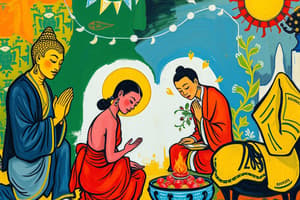Podcast
Questions and Answers
The Eight-fold path is the basis for Buddhist ______.
The Eight-fold path is the basis for Buddhist ______.
ethics
The most iconic Buddhist symbol is the ______ Wheel.
The most iconic Buddhist symbol is the ______ Wheel.
Dharma
The five precepts are ethical guidelines that speak of what to ______, rather than what to do.
The five precepts are ethical guidelines that speak of what to ______, rather than what to do.
avoid
The lotus flower symbolizes ______, which is central to Buddhism.
The lotus flower symbolizes ______, which is central to Buddhism.
The three swirls in the middle of the Dharma Wheel symbolize the three jewels of Buddhism: Buddha, the ______, and the sangha.
The three swirls in the middle of the Dharma Wheel symbolize the three jewels of Buddhism: Buddha, the ______, and the sangha.
In Buddhism, the ______ refers to the monastic community of monks and nuns.
In Buddhism, the ______ refers to the monastic community of monks and nuns.
The practices of the ______ are considered daily rituals that guide ethical living in Buddhism.
The practices of the ______ are considered daily rituals that guide ethical living in Buddhism.
Buddhists engage in ______ to achieve a state of peacefulness and awareness of their thoughts and intentions.
Buddhists engage in ______ to achieve a state of peacefulness and awareness of their thoughts and intentions.
A common method of practicing meditation includes sitting, breathing, and reciting ______.
A common method of practicing meditation includes sitting, breathing, and reciting ______.
Chanting in Buddhism can occur as an act of worship or as part of preparation for ______.
Chanting in Buddhism can occur as an act of worship or as part of preparation for ______.
In order to practice 'right concentration' within the Eightfold Path, chanting may involve reciting a ______.
In order to practice 'right concentration' within the Eightfold Path, chanting may involve reciting a ______.
The laity in Buddhism refers to non-ordinated practitioners, distinguishing them from the ______.
The laity in Buddhism refers to non-ordinated practitioners, distinguishing them from the ______.
The ______ is often viewed as a way to alleviate the suffering associated with 'wanting more.'
The ______ is often viewed as a way to alleviate the suffering associated with 'wanting more.'
Flashcards are hidden until you start studying
Study Notes
Social Structure
- Buddhism is organized into two main groups: the sangha (monastic community of monks and nuns) and the laity (non-ordained practitioners).
- Monastics are distinguished by their shaved heads and traditional robes.
- The structure can vary significantly by region.
Rituals
- The Eightfold Path: Consists of eight ways of living that guide Buddhists in ethical behavior and daily practices, aiming to alleviate suffering and achieve Nirvana.
- Meditation: A fundamental practice that helps individuals gain control over their mind, leading to inner peace and awareness. Various techniques include sitting, breathing, and reciting mantras.
- Chanting: Performed as part of meditation or worship, it fosters 'right concentration' and supports the Eightfold Path. Contents may include Buddhist texts, prayers, or mantras.
Ethics
- The Eightfold Path forms the foundation of Buddhist ethics, influencing how adherents should live and act, emphasizing interconnectedness among its eight components.
- Right Speech, Right Action, and Right Livelihood: These three spokes are particularly focused on ethical conduct.
- The Five Precepts: These guidelines outline what to avoid, contrasting with the Eightfold Path, and serve as ethical principles for Buddhists.
Symbols
- Dharma Wheel: Represents Buddha’s teachings and the Eightfold Path through its eight spokes. The center swirls symbolize the Three Jewels: Buddha (teacher), Dharma (teachings), and Sangha (community).
- Lotus Flower: A symbol of enlightenment, illustrating the growth through challenges, as it rises from muddy waters to bloom beautifully, representing purity and spiritual awakening.
Studying That Suits You
Use AI to generate personalized quizzes and flashcards to suit your learning preferences.




